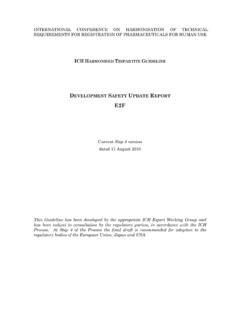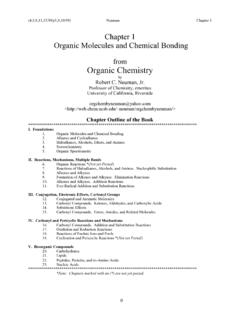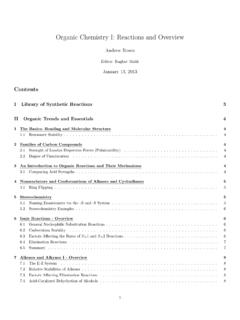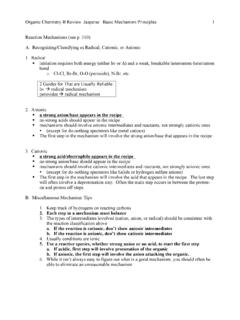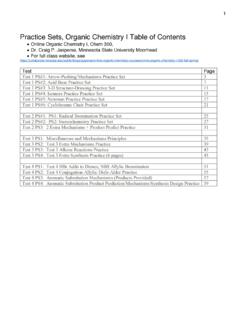Transcription of IMPURITIES IN EW DRUG SUBSTANCES Q3A(R2) - ICH
1 INTERNATIONAL CONFERENCE ON HARMONISATION OF TECHNICAL REQUIREMENTS FOR REGISTRATION OF PHARMACEUTICALS FOR HUMAN USE ICH HARMONISED TRIPARTITE GUIDELINE IMPURITIES IN NEW DRUG SUBSTANCES Q3A(R2) Current Step 4 version dated 25 October 2006 This Guideline has been developed by the appropriate ICH Expert Working Group and has been subject to consultation by the regulatory parties, in accordance with the ICH Process. At Step 4 of the Process the final draft is recommended for adoption to the regulatory bodies of the European Union, Japan and USA. Q3A(R2) Document History First Codification History Date New Codification November 2005 Q3 Approval by the Steering Committee under Step 2 and release for public consultation.
2 15 March 1994 Q3A Q3A Approval by the Steering Committee under Step 4 and recommendation for adoption to the three ICH regulatory bodies. Q3 was renamed Q3A. 30 March 1995 Q3A Q3A(R) Approval by the Steering Committee of the first Revision under Step 2 and release for public consultation. 7 October 1999 Q3A(R1) Q3A(R) Approval by the Steering Committee of the first Revision under Step 4 and recommendation for adoption to the three ICH regulatory bodies. 6 February 2002 Q3A(R1) Current Step 4 version Q3A(R2) Approval by the Steering Committee of the revision of the Attachment 2 directly under Step 4 without further public consultation. 25 October 2006 Q3A(R2) IMPURITIES IN NEW DRUG SUBSTANCES ICH Harmonised Tripartite Guideline Having reached Step 4 of the ICH Process at the ICH Steering Committee meeting on 7 February 2002, this guideline is recommended for adoption to the three regulatory parties to ICH.
3 Attachment 2 has been revised on 25 October 2006. TABLE OF CONTENTS 1. 2. CLASSIFICATION OF 3. RATIONALE FOR THE REPORTING AND CONTROL OF organic Inorganic 4. ANALYTICAL 5. REPORTING IMPURITY CONTENT OF 6. LISTING OF IMPURITIES IN 7. QUALIFICATION OF 8. ATTACHMENT ATTACHMENT ATTACHMENT i IMPURITIES IN NEW DRUG SUBSTANCES 1. PREAMBLE This document is intended to provide guidance for registration applications on the content and qualification of IMPURITIES in new drug SUBSTANCES produced by chemical syntheses and not previously registered in a region or member state. It is not intended to apply to new drug SUBSTANCES used during the clinical research stage of development. The following types of drug SUBSTANCES are not covered in this guideline: biological/biotechnological, peptide, oligonucleotide, radiopharmaceutical, fermentation product and semi-synthetic products derived therefrom, herbal products, and crude products of animal or plant origin.
4 IMPURITIES in new drug SUBSTANCES are addressed from two perspectives: Chemistry Aspects include classification and identification of IMPURITIES , report generation, listing of IMPURITIES in specifications, and a brief discussion of analytical procedures; and Safety Aspects include specific guidance for qualifying those IMPURITIES that were not present, or were present at substantially lower levels, in batches of a new drug substance used in safety and clinical studies. 2. CLASSIFICATION OF IMPURITIES IMPURITIES can be classified into the following categories: organic IMPURITIES (process- and drug-related) Inorganic IMPURITIES Residual solvents organic IMPURITIES can arise during the manufacturing process and/or storage of the new drug substance. They can be identified or unidentified, volatile or non-volatile, and include: Starting materials By-products Intermediates Degradation products Reagents, ligands and catalysts Inorganic IMPURITIES can result from the manufacturing process.
5 They are normally known and identified and include: Reagents, ligands and catalysts Heavy metals or other residual metals Inorganic salts Other materials ( , filter aids, charcoal) Solvents are inorganic or organic liquids used as vehicles for the preparation of solutions or suspensions in the synthesis of a new drug substance. Since these are 1 IMPURITIES in New Drug SUBSTANCES 2 generally of known toxicity, the selection of appropriate controls is easily accomplished (see ICH Guideline Q3C on Residual Solvents). Excluded from this document are: (1) extraneous contaminants that should not occur in new drug SUBSTANCES and are more appropriately addressed as Good Manufacturing Practice (GMP) issues, (2) polymorphic forms, and (3) enantiomeric IMPURITIES . 3. RATIONALE FOR THE REPORTING AND CONTROL OF IMPURITIES organic IMPURITIES The applicant should summarise the actual and potential IMPURITIES most likely to arise during the synthesis, purification, and storage of the new drug substance.
6 This summary should be based on sound scientific appraisal of the chemical reactions involved in the synthesis, IMPURITIES associated with raw materials that could contribute to the impurity profile of the new drug substance, and possible degradation products. This discussion can be limited to those IMPURITIES that might reasonably be expected based on knowledge of the chemical reactions and conditions involved. In addition, the applicant should summarise the laboratory studies conducted to detect IMPURITIES in the new drug substance. This summary should include test results of batches manufactured during the development process and batches from the proposed commercial process, as well as the results of stress testing (see ICH Guideline Q1A on Stability) used to identify potential IMPURITIES arising during storage. The impurity profile of the drug substance batches intended for marketing should be compared with those used in development, and any differences discussed.
7 The studies conducted to characterise the structure of actual IMPURITIES present in the new drug substance at a level greater than (>) the identification threshold given in Attachment 1 ( , calculated using the response factor of the drug substance) should be described. Note that any impurity at a level greater than (>) the identification threshold in any batch manufactured by the proposed commercial process should be identified. In addition, any degradation product observed in stability studies at recommended storage conditions at a level greater than (>) the identification threshold should be identified. When identification of an impurity is not feasible, a summary of the laboratory studies demonstrating the unsuccessful effort should be included in the application. Where attempts have been made to identify IMPURITIES present at levels of not more than ( ) the identification thresholds, it is useful also to report the results of these studies.
8 Identification of IMPURITIES present at an apparent level of not more than ( ) the identification threshold is generally not considered necessary. However, analytical procedures should be developed for those potential IMPURITIES that are expected to be unusually potent, producing toxic or pharmacological effects at a level not more than ( ) the identification threshold. All IMPURITIES should be qualified as described later in this guideline. Inorganic IMPURITIES Inorganic IMPURITIES are normally detected and quantified using pharmacopoeial or other appropriate procedures. Carry-over of catalysts to the new drug substance should be evaluated during development. The need for inclusion or exclusion of inorganic IMPURITIES in the new drug substance specification should be discussed. IMPURITIES in New Drug SUBSTANCES 3 Acceptance criteria should be based on pharmacopoeial standards or known safety data.
9 Solvents The control of residues of the solvents used in the manufacturing process for the new drug substance should be discussed and presented according to the ICH Q3C Guideline for Residual Solvents. 4. ANALYTICAL PROCEDURES The registration application should include documented evidence that the analytical procedures are validated and suitable for the detection and quantification of IMPURITIES (see ICH Q2A and Q2B Guidelines for Analytical Validation). Technical factors ( , manufacturing capability and control methodology) can be considered as part of the justification for selection of alternative thresholds based on manufacturing experience with the proposed commercial process. The use of two decimal places for thresholds (See Attachment 1) does not necessarily reflect the precision of the analytical procedure used for routine quality control purposes.
10 Thus, the use of lower precision techniques ( , thin-layer chromatography) can be acceptable where justified and appropriately validated. Differences in the analytical procedures used during development and those proposed for the commercial product should be discussed in the registration application. The quantitation limit for the analytical procedure should be not more than ( ) the reporting threshold. organic impurity levels can be measured by a variety of techniques, including those that compare an analytical response for an impurity to that of an appropriate reference standard or to the response of the new drug substance itself. Reference standards used in the analytical procedures for control of IMPURITIES should be evaluated and characterised according to their intended uses. The drug substance can be used as a standard to estimate the levels of IMPURITIES .
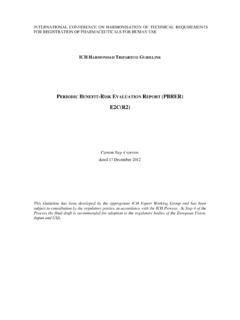
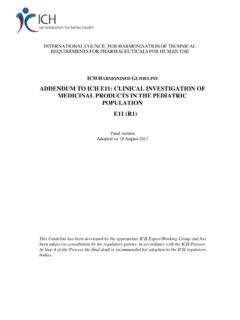
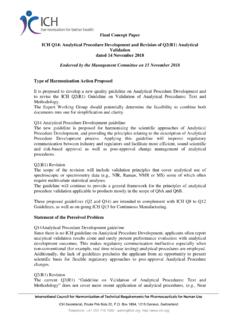
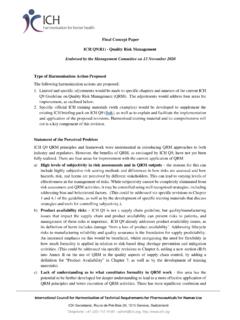
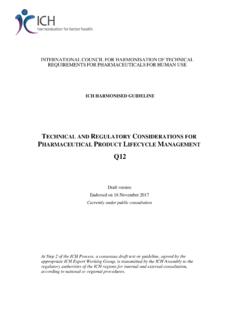
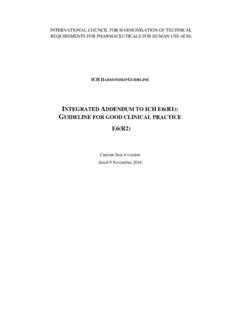
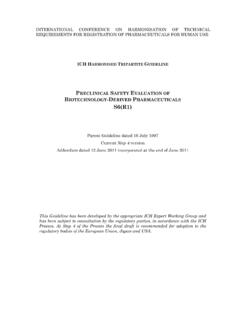
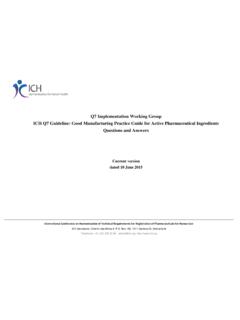
![[ICH E2F] [EXAMPLE DSUR – PHASE III INVESTIGATIONAL …](/cache/preview/e/7/a/2/e/6/3/0/thumb-e7a2e63043c4463724e748eb98faa3a7.jpg)
